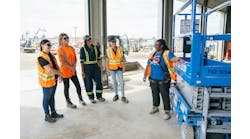Construction companies added 31,000 workers in October as the industry’s unemployment rate declined to 6.2 percent with robust demand for construction, according to an analysis by the Associated General Contractors of America. AGC offices said construction employment is now at its highest level since February 2009 as the sector continues its recovery from the downturn.
“The industry continues to recover while the hiring slowdowns in experienced during the summer were prompted more by labor shortages than they were any slump in demand,” said Ken Simonson, AGC’s chief economist. “Construction firms appear to have had an easier time finding workers in October than they did during the summer.”
Construction employment totaled 6,434,000 in October, the most since February 2009, and is up by 233,000 jobs compared to a year ago, a 3.8 percent increase. Residential construction jumped by 6,000 in October and 99,100 or 4.2 percent compared to a year ago. Nonresidential construction employers added 24,900 jobs for the month and 133,800 jobs compared to last October, a 4.5 percent hike.
The Census Bureau release data on Nov. 2 showing that the growth in construction spending accelerated to a seven-year high of 14.1 percent between Sept. 2014 and Sept. 2015.
Simonson added that construction wages have been consistently rising for the past four years and averaged $27.54 per hour in October, 9.3 percent more than the average for all nonfarm payroll employees. Average hourly earnings in construction increased 2.6 percent from Oct. 2014 to Oct. 2015.
In other AGC news, AGC’s CEO Stephen Sandherr said the U.S. House of Representatives’ passage of a new surface transportation bill will help states repair roads but does not address long-term funding issues.
“It is encouraging to see overwhelming House support for a long-term highway and transit measure,” Sandherr said. “[The] vote sends a strong message that Washington officials can find a way to work together to help address crucial problems like aging roads, decaying transit system and unsafe bridges. The new measure will provide state officials with the resources they need to improve road safety, cut congestion and cut shipping and transport costs for millions of American businesses.
“As needed as this new measure is, both the House and Senate have failed to address the long-term funding challenges that have repeatedly threatened the viability of the federal transportation program. That is why we will continue to work aggressively to make sure that Congress not only completes this vital measure but that our elected leaders include a viable, long-term solution for funding future transportation investments either in this measure or another bill.”









